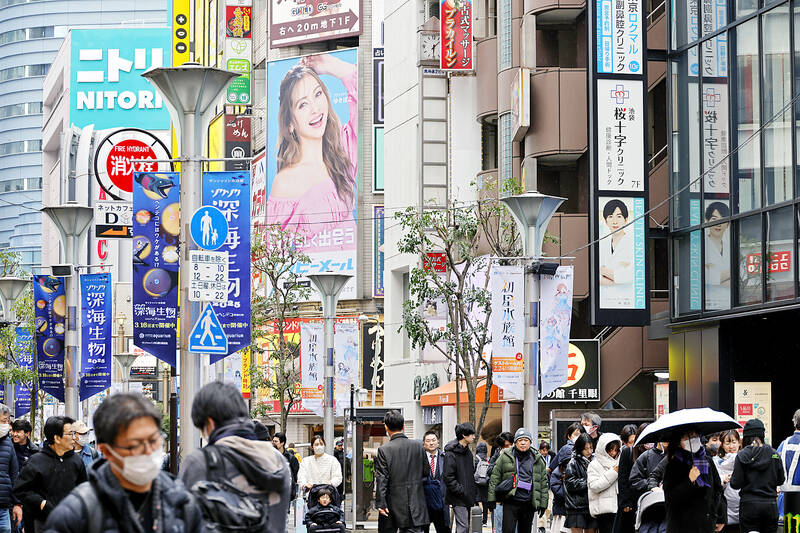Japan’s economy grew at a better-than-expected annual rate of 2.8 percent in the October-to-December quarter last year, underlined by steady exports and moderate consumption.
On a quarter-to-quarter basis, the world’s fourth-largest economy grew 0.7 percent for its third straight quarter of growth, the Japanese Cabinet Office reported yesterday in its preliminary data.
The fourth-quarter figure was more than double market expectations of 0.3 percent growth.

Photo: EPA-EFE
For the whole of last year, the Japanese economy eked out 0.1 percent growth in seasonally adjusted real GDP, the fourth straight year of expansion but down from 1.5 percent the year before, the data showed.
Private consumption grew at an annual rate of 0.5 percent during the three months through December, holding up while losing momentum. Exports jumped 4.3 percent, and capital investment increased 0.5 percent.
Some analysts think the anticipation of US President Donald Trump’s tariffs might have lifted trade.
Unlike the US and some other nations, Japan has been dogged by deflation, and these lower prices stifle growth. However, recent wage growth has kept deflationary trends in check.
Recent data show inflation is at about the Bank of Japan’s target of 2 percent. Higher prices are crimping consumer spending, which makes up for more than half the economy.
The central bank might move to further raise interest rates, which were at zero or below zero for years to wrest the economy out of deflation. It raised its key interest rate to about 0.5 percent from 0.25 percent last month, saying that inflation is holding at a desirable target level. The next monetary policy meeting is next month.
“Stronger growth may reinforce expectations for the Bank of Japan to push through with further hikes, while the slowdown in private consumption growth may be addressed by the prospects of higher wages ahead,” IG Asia Pte market strategist Yeap Jun Rong (葉俊榮) said.

UNCERTAINTY: Innolux activated a stringent supply chain management mechanism, as it did during the COVID-19 pandemic, to ensure optimal inventory levels for customers Flat-panel display makers AUO Corp (友達) and Innolux Corp (群創) yesterday said that about 12 to 20 percent of their display business is at risk of potential US tariffs and that they would relocate production or shipment destinations to mitigate the levies’ effects. US tariffs would have a direct impact of US$200 million on AUO’s revenue, company chairman Paul Peng (彭雙浪) told reporters on the sidelines of the Touch Taiwan trade show in Taipei yesterday. That would make up about 12 percent of the company’s overall revenue. To cope with the tariff uncertainty, AUO plans to allocate its production to manufacturing facilities in

TAKING STOCK: A Taiwanese cookware firm in Vietnam urged customers to assess inventory or place orders early so shipments can reach the US while tariffs are paused Taiwanese businesses in Vietnam are exploring alternatives after the White House imposed a 46 percent import duty on Vietnamese goods, following US President Donald Trump’s announcement of “reciprocal” tariffs on the US’ trading partners. Lo Shih-liang (羅世良), chairman of Brico Industry Co (裕茂工業), a Taiwanese company that manufactures cast iron cookware and stove components in Vietnam, said that more than 40 percent of his business was tied to the US market, describing the constant US policy shifts as an emotional roller coaster. “I work during the day and stay up all night watching the news. I’ve been following US news until 3am

COLLABORATION: Given Taiwan’s key position in global supply chains, the US firm is discussing strategies with local partners and clients to deal with global uncertainties Advanced Micro Devices Inc (AMD) yesterday said it is meeting with local ecosystem partners, including Taiwan Semiconductor Manufacturing Co (TSMC, 台積電), to discuss strategies, including long-term manufacturing, to navigate uncertainties such as US tariffs, as Taiwan occupies an important position in global supply chains. AMD chief executive officer Lisa Su (蘇姿丰) told reporters that Taiwan is an important part of the chip designer’s ecosystem and she is discussing with partners and customers in Taiwan to forge strong collaborations on different areas during this critical period. AMD has just become the first artificial-intelligence (AI) server chip customer of TSMC to utilize its advanced

Six years ago, LVMH’s billionaire CEO Bernard Arnault and US President Donald Trump cut the blue ribbon on a factory in rural Texas that would make designer handbags for Louis Vuitton, one of the world’s best-known luxury brands. However, since the high-profile opening, the factory has faced a host of problems limiting production, 11 former Louis Vuitton employees said. The site has consistently ranked among the worst-performing for Louis Vuitton globally, “significantly” underperforming other facilities, said three former Louis Vuitton workers and a senior industry source, who cited internal rankings shared with staff. The plant’s problems — which have not